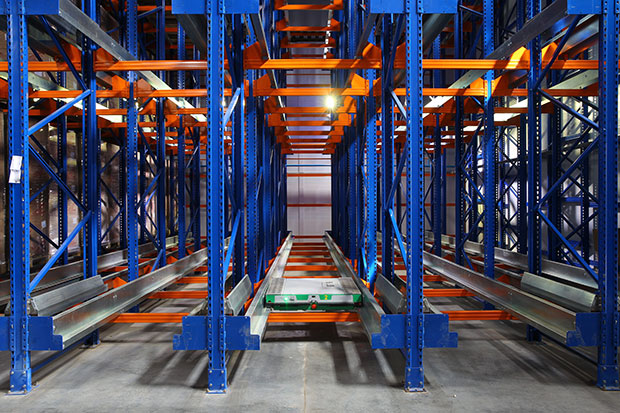Why automate?
The adoption of automation technologies addresses both operational efficiency and labour shortages. It has become a business imperative, especially in e-commerce warehouses. The proliferation of more, smaller distribution facilities has created a need for more efficient and flexible storage solutions. Automation saves time.
 Stackers and Shuttles
Stackers and Shuttles
An automated storage and retrieval system (AS/RS) using stacker cranes is a well-established and proven technology in large manufacturing and distribution facilities. A stacker crane moves in an aisle horizontally and vertically along a rail mounted in the floor, while the guiding profile is mounted at the top of a rack. They typically replace large areas of shelving to save floor space, improve safety, and increase productivity. Shuttle systems for automated warehouses managing high volume, small items are not new. Pallet shuttles are small vehicles with a low height and with a footprint similar to the pallet they are moving. They move on rails within the storage lanes of the racking system to bring pallets to and from a loading/unloading end aisle. Shuttles operate in two dimensions in each ‘layer’ of the racking system but can be transferred vertically as well as between lanes.
Evaluating stackers and shuttles
Evaluating stacker cranes and shuttle automation systems in a warehouse involves assessing various factors to determine their effectiveness, efficiency, and suitability. Every use case is different but here are the main considerations:
Operational efficiency
How well does each system utilise warehouse space i.e., vertical storage capacity and aisle width?
How will each option impact labour requirements and productivity?
What will the energy consumption and cost be?
Flexibility and scalability
How will the crane ASRS or shuttle automation system integrate with existing warehouse management software (WMS)?
Can the system you are considering scale up or down to meet changing business demands, such as seasonal fluctuations or business growth? Changes could include inventory volume, workflow changes, or warehouse layout.
Will the new system be compatible with other warehouse equipment and technologies, such as conveyor systems, or barcode scanners and sensors?
Total Cost of Ownership
How much is the outlay? Evaluate the upfront costs associated with implementing the system, including equipment purchase, installation, and setup.
What are the ongoing operational costs such as maintenance, repairs, energy consumption, and system upgrades over the system’s lifespan?
Calculate the Return on Investment (ROI) based on improvements in efficiency, labour savings, and other non-financial benefits.
Performance measures
Can the system handle your inbound and outbound volumes within your given time frame?
What is the expected system downtime and what are the reasons for it?
Operational considerations Stackers
Warehouse stacker cranes (AS/RS) make the most efficient use of storage space and offer many possibilities for mechanising and automating storage, order picking and transport. These machines are designed for the automatic lifting and stacking of loads on racks up to 40 metres.
Shuttles
Automated vehicle shuttles are flexible and scalable and suitable for smaller micro-fulfilment and agile warehouses with up to 5000 pallet locations. These systems are quick to install, even in existing buildings with limited space. Several shuttle vehicles can travel simultaneously in each aisle or level. The lift is performed by vertical lifters, 18 metres high is common, up to 25 metres is possible. Vehicle shuttle solutions reduce the amount of ‘wasted’ aisle space required.
SCCG has experts in warehouse automation who will work with you on automation and design and layout projects. Whether you’re optimising your current setup or embarking on a full-scale automation project, SCCG’s bespoke design and layout services could promise a seamless transition. Contact us at +44(0)1926 430 883 or info@sccgltd.com.




Comments are closed.